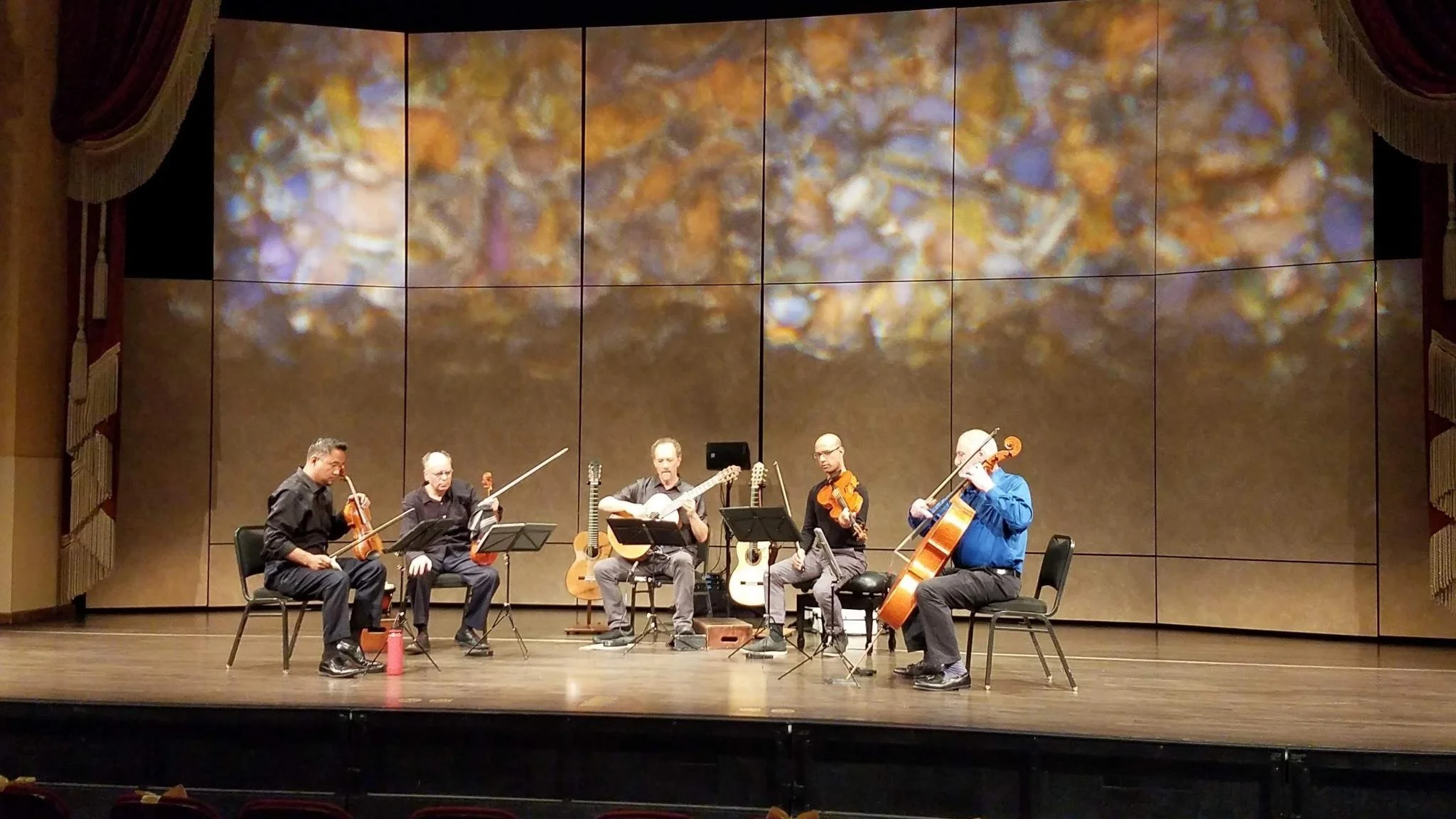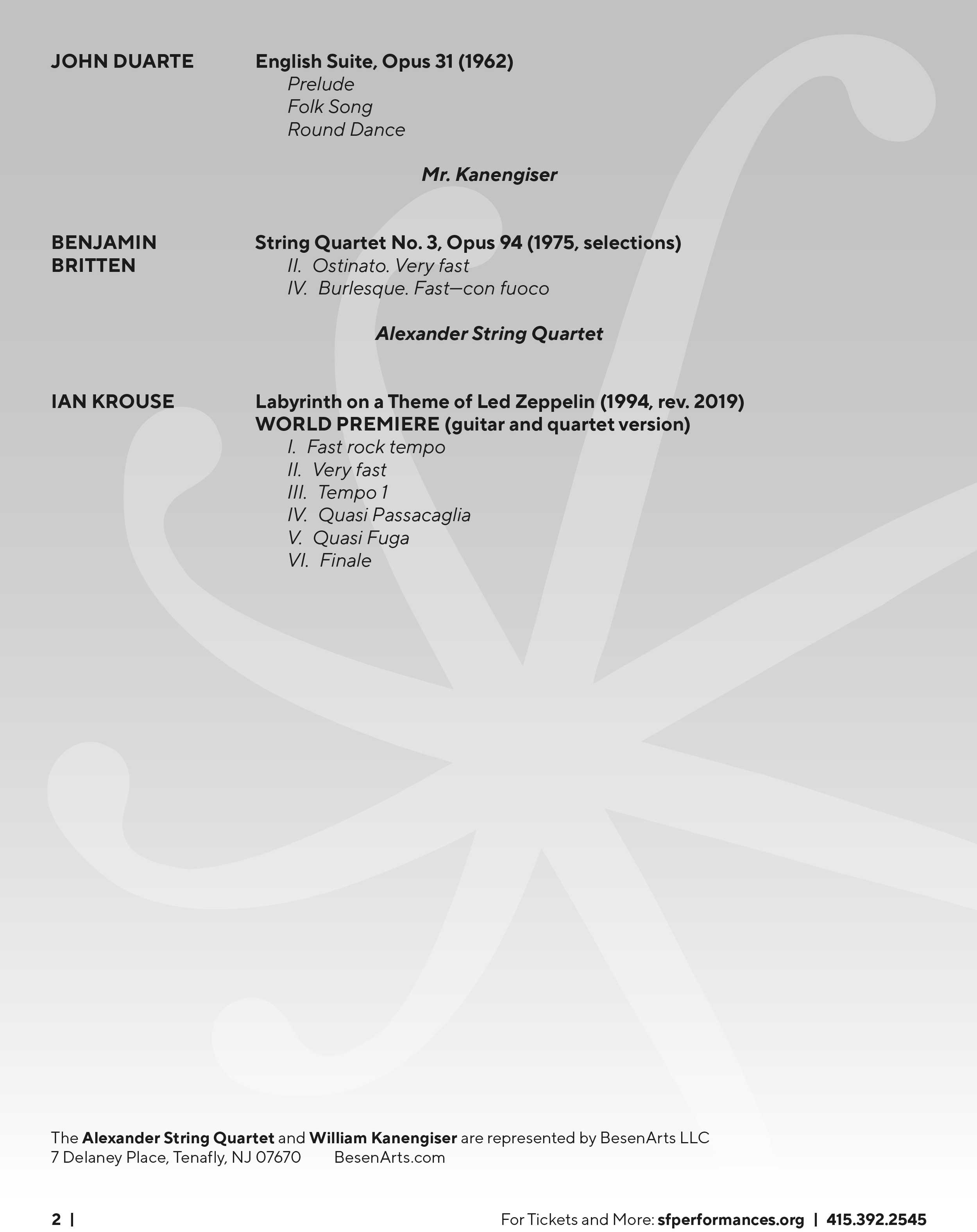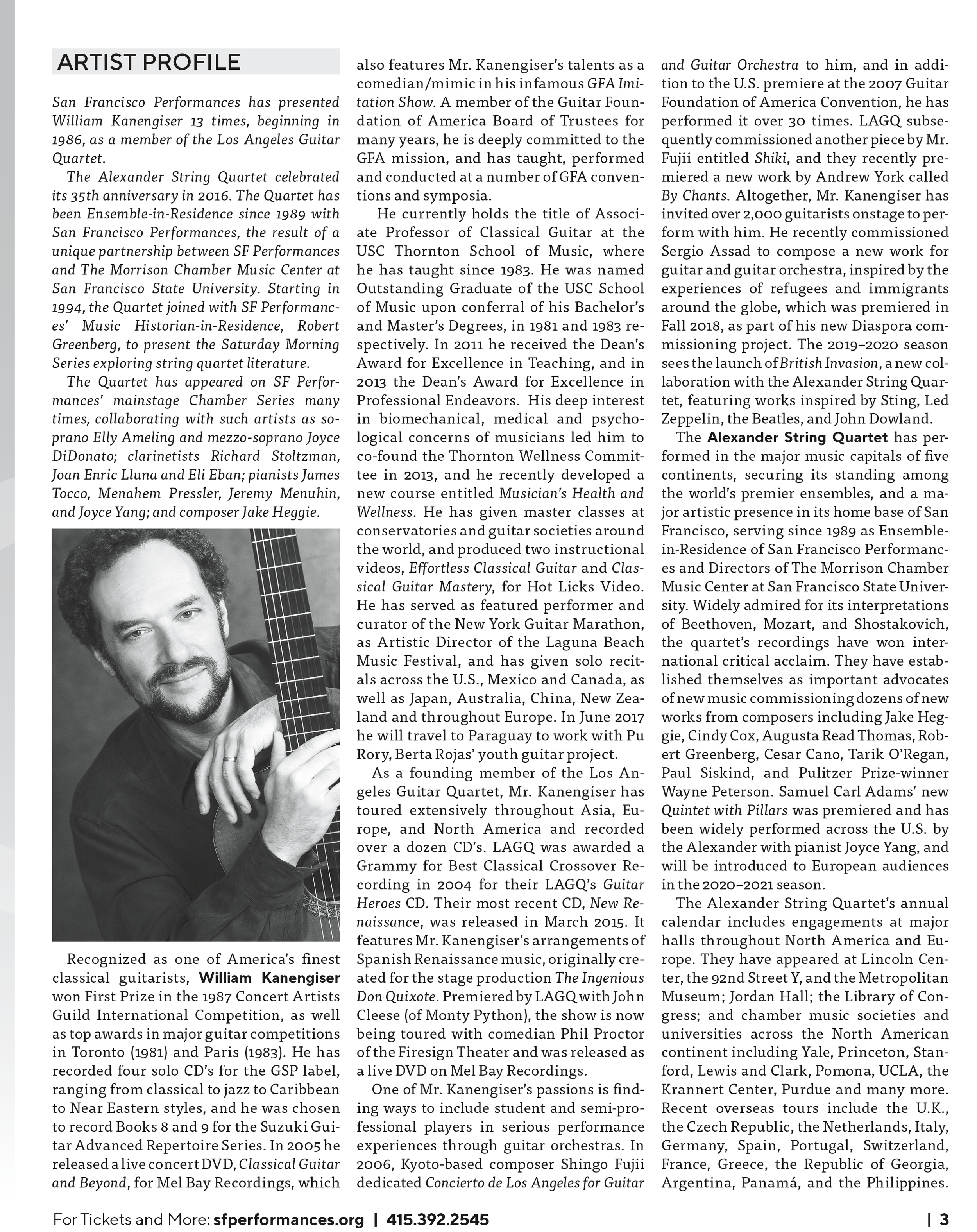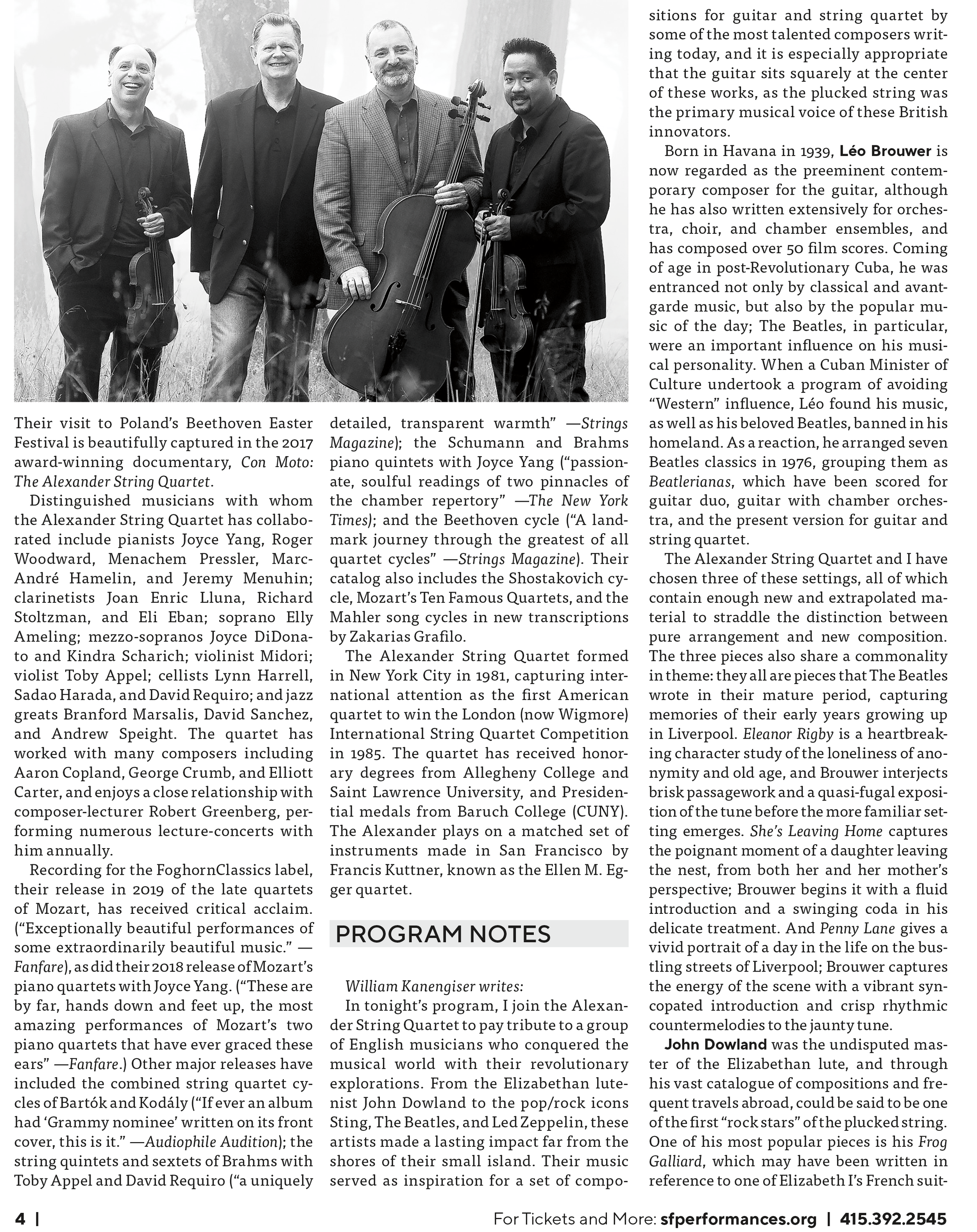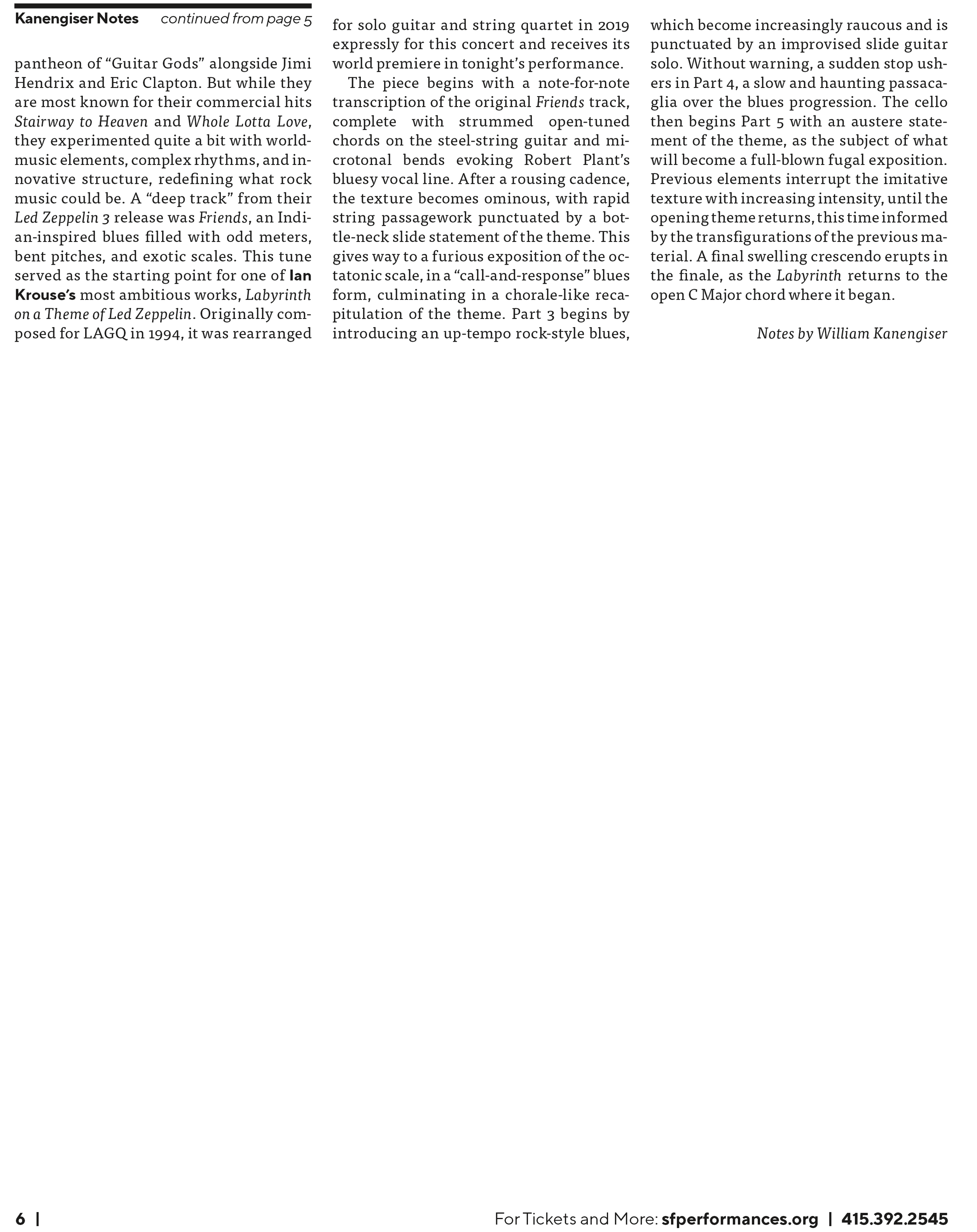“British Invasion” Concert - Bill Kanengiser & Alexander String Quartet
Saturday March 7 will be an exciting day for me! It’s the first performance of a truly eclectic new program I’ve put together with the incredible Alexander String Quartet, at San Francisco’s Herbst Theater. We’ll be playing music by The Beatles, Sting, John Dowland and Led Zeppelin, re-orchestrated and reimagined by the wonderful composers Léo Brouwer, Dusan Bogdanovic, and Ian Krouse. We’ll do the North American premiere of Dusan’s “Prisms: Six Songs by Sting” and the World premiere of the Guitar and String Quartet version of Ian Krouse’s “Labyrinth on a Theme of Led Zeppelin”. Plus, ASQ will play some Britten and I’ll play Duarte’s lovely “English Suite”. Should be jolly good! Join me as I explore this challenging and vibrant new repertoire with the wonderful ASQ, and watch me whip out the steel-string, the pick and the bottleneck slide!
Update Summer 2021: This concert was postponed until July 16, 2021 due to the COVID-19 pandemic.
Update Winter 2021: We recorded “British Invasion” with the Alexander String Quartet! More info on the next post.
Here are the notes I wrote for the concert:
In tonight’s program, I join the Alexander String Quartet to pay tribute to a group of English musicians who conquered the musical world with their revolutionary explorations. From the Elizabethan lutenist John Dowland to the pop/rock icons Sting, The Beatles, and Led Zeppelin, these artists made a lasting impact far from the shores of their small island. Their music served as inspiration for a set of compositions for guitar and string quartet by some of the most talented composers writing today, and it is especially appropriate that the guitar sits squarely at the center of these works, as the plucked string was the primary musical voice of these British innovators.
Born in Havana in 1939, Léo Brouwer is now regarded as the preeminent contemporary composer for the guitar, although he has also written extensively for orchestra, choir, and chamber ensembles, and has composed over 50 film scores. Coming of age in post-Revolutionary Cuba, he was entranced not only by classical and avantgarde music, but also by the popular music of the day; The Beatles, in particular, were an important influence on his musical personality. When a Cuban Minister of Culture undertook a program of avoiding “Western” influence, Léo found his music, as well as his beloved Beatles, banned in his homeland. As a reaction, he arranged seven Beatles classics in 1976, grouping them as Beatlerianas, which have been scored for guitar duo, guitar with chamber orchestra, and the present version for guitar and string quartet.
The Alexander String Quartet and I have chosen three of these settings, all of which contain enough new and extrapolated material to straddle the distinction between pure arrangement and new composition. The three pieces also share a commonality in theme: they all are pieces that The Beatles wrote in their mature period, capturing memories of their early years growing up in Liverpool. Eleanor Rigby is a heartbreaking character study of the loneliness of anonymity and old age, and Brouwer interjects brisk passagework and a quasi-fugal exposition of the tune before the more familiar setting emerges. She’s Leaving Home captures the poignant moment of a daughter leaving the nest, from both her and her mother’s perspective; Brouwer begins it with a fluid introduction and a swinging coda in his delicate treatment. And Penny Lane gives a vivid portrait of a day in the life on the bustling streets of Liverpool; Brouwer captures the energy of the scene with a vibrant syncopated introduction and crisp rhythmic countermelodies to the jaunty tune.
John Dowland was the undisputed master of the Elizabethan lute, and through his vast catalogue of compositions and frequent travels abroad, could be said to be one of the first “rock stars” of the plucked string. One of his most popular pieces is his Frog Galliard, which may have been written in reference to one of Elizabeth I’s French suitors, the Duc d’Alençon. Dowland also set the piece to text in his lute song Now, O Now, I Needs Must Part. (The triple meter and cyclical harmony of the piece have suggested to some that Herr Pachelbel might have lifted it for his famous Canon in D theme.) The contemporary composer Ian Krouse used this theme as a springboard for a major work, first written for two guitars under the title Portrait of a Young Woman, and then re-cast for solo guitar and string quartet (it was later re-arranged for four guitars, and I recorded it with the Los Angeles Guitar Quartet on our New Renaissance album).
Ian Krouse, a Distinguished Professor of Composition at UCLA, is prolific and lauded composer of symphonies, chamber works and song cycles. (He is most recognized for his magnum opus, Armenian Requiem.) But as a guitarist himself, he is particularly associated with that instrument, and especially through his long and fruitful collaboration with LAGQ. In setting the Frog Galliard, Krouse created a two-part work that deconstructs, reconstructs, and reimagines the theme both melodically and harmonically. Krouse also used the conceit of limiting himself to the seven notes of the key of E Major, to see how much contrast and formal development could be achieved within that constraint: hence the title Music in Four Sharps. The first half of the piece owes a debt to Benjamin Britten’s masterwork for solo guitar, Nocturnal after John Dowland, Opus 70, which also happens to be a setting of a Dowland theme (Come, Heavy Sleep); like the Nocturnal, Music in Four Sharps presents a set of variations that reveals the theme at the end, rather than at the outset. While the statement of the theme was the endpoint for Britten’s setting, for Krouse it marks the middle point. From then on, the piece becomes a quasiminimalistic fracturing and rhythmic overlay of snippets of the tune that gradually builds to a searing climax. As the dust settles, the theme returns as a faint echo, fading out a niente.
Sting (born Gordon Sumner) has redefined what a pop artist can be over his multifaceted career; he is a rock star, a jazz musician, a world-music advocate, an early music aficionado, an actor, and now, a Broadway playwright and headliner in his musical The Last Ship. Along the way, he created a catalogue of songs that have become anthems for a whole generation. In 2013, the contemporary Serbian composer Dušan Bogdanović undertook the project of setting six of Sting’s tunes into Prism: Six Songs by Sting for solo guitar and string quartet. The genesis of the collaboration was through Sting’s exploration into Elizabethan lute and the music of John Dowland in his project Songs from the Labyrinth. There he worked with the Croatian lutenist Edin Karamazov, who is a frequent performer of Dušan’s music. Edin commissioned Dušan to set the songs, and with Sting’s blessing, the pieces have been performed and recorded. Tonight’s performance will mark the North American premiere of the set.
Bogdanović chose six songs that highlight the stylistic and emotional range of Sting’s songwriting, in adaptations that are even more extrapolated and re-composed than the aforementioned Beatles settings by Brouwer. Dušan’s iconic style comes through clearly with a penchant for odd-meters, rich harmonies, polymeter, and jazz textures, making it a perfect foil to Sting’s pop-infused multistylistic approach. The simplest of the settings is Every Breath You Take, with the time signature set to a more Balkan 7/8, and a cello ostinato reminiscent of the Prelude of Bach’s Cello Suite No. 1. Next is Message in a Bottle, churning with an African-inspired polyrhythm, which climaxes in a highly syncopated 12/8 groove. Shape of My Heart is a duet for cello and guitar, with a mournful, bluesy setting of this lovely ballad. Fields of Gold is a dialogue between guitar and the string quartet, with luscious harmonies over the hymn-like melody. Desert Rose begins with a short guitar solo in a North African style, which unfolds into the ostinato of the tune, again re-imagined in 7/8. The final movement is the rock anthem Roxanne, here set as a passacaglia that becomes increasingly complex, polytonal, and polyrhythmic, culminating in a frenetic post-modern be-bop coda.
Although not a household name, John Duarte was an influential force in the development of the classical guitar in the 20th Century. A noted critic, scholar, recording annotator, and competition juror, he was a close personal friend of the Spanish virtuoso Andrés Segovia, and one of John Williams’ primary instructors. He composed over 150 works for guitar, as well as editing and arranging works by Manuel de Falla and Bach. By far his most popular piece, the English Suite, Opus 31, captures the essence of British 20th Century pastoral music, in a charming neo-Renaissance style that fully explores the guitar’s resonant potential. The piece was written in 1962 and carries the dedication: “To Andrés Segovia and his wife on the occasion of their marriage.”
Cast in three movements, English Suite begins with a Prelude that evokes the processional to Segovia’s wedding. A slow and lyrical middle section features a gradually unfolding theme that hints at the exchange of vows, and the opening material returns as a recessional march. The second movement, Folk Song, explores a simple pentatonic melody that weaves up and down the guitar’s range, then moves into unexpected tonal centers on undulating chordal waves, including a nod to the Spanish music of his dedicatee. The final Round Dance is a jig in 9/8, diverted by a brief foray into a plaintive chorale, and it ends satisfyingly in a rousing flourish.
Eric Bromberger writes on Britten’s String Quartet No. 3: In 1973 Benjamin Britten—frail and facing a heart operation—composed his final opera, Death in Venice. Based on Thomas Mann’s 1913 novella, the opera summed up many of the themes of Britten’s artistic career: as the aging novelist Aschenbach embarks on a quest for spiritual redemption in a city assaulted by the plague, he is torn between his search for beauty and the corrupting force of his own physical desires. Two years later, in the fall of 1975, Britten composed his String Quartet No. 3. It would be (except for a short choral piece for children) his final composition, for Britten died of heart failure the following year. The Amadeus Quartet gave the official premiere of this quartet on December 19, 1976, two weeks after the composer’s death, though Britten had heard this music played through shortly after he completed it. In the course of composing the quartet, Britten returned to Venice—a city he loved—and in fact he composed the quartet’s final movement there. Inevitably, that visit reawakened memories of his opera, and this quartet makes explicit references to Death in Venice: specific themes, key relationships, and mottos that had appeared in the opera return in the quartet. This all raises a question: does one need to know Death in Venice to understand the Quartet No. 3? The answer to that question must be no—this quartet will stand on its own merits—but it may help to know that this was Britten’s final instrumental work and that it draws on music about a spiritual quest.
Led Zeppelin still stands as one of the most emblematic and innovative rock groups in history, and the guitar stylings of Jimmy Page puts him firmly in the pantheon of “Guitar Gods” alongside Jimi Hendrix and Eric Clapton. But while they are most known for their commercial hits Stairway to Heaven and Whole Lotta Love, they experimented quite a bit with worldmusic elements, complex rhythms, and innovative structure, redefining what rock music could be. A “deep track” from their Led Zeppelin 3 release was Friends, an Indian-inspired blues filled with odd meters, bent pitches, and exotic scales. This tune served as the starting point for one of Ian Krouse’s most ambitious works, Labyrinth on a Theme of Led Zeppelin. Originally composed for LAGQ in 1994, it was rearranged for solo guitar and string quartet in 2019 expressly for this concert and receives its world premiere in tonight’s performance.
The piece begins with a note-for-note transcription of the original Friends track, complete with strummed open-tuned chords on the steel-string guitar and microtonal bends evoking Robert Plant’s bluesy vocal line. After a rousing cadence, the texture becomes ominous, with rapid string passagework punctuated by a bottle-neck slide statement of the theme. This gives way to a furious exposition of the octatonic scale, in a “call-and-response” blues form, culminating in a chorale-like recapitulation of the theme. Part 3 begins by introducing an up-tempo rock-style blues, which become increasingly raucous and is punctuated by an improvised slide guitar solo. Without warning, a sudden stop ushers in Part 4, a slow and haunting passacaglia over the blues progression. The cello then begins Part 5 with an austere statement of the theme, as the subject of what will become a full-blown fugal exposition. Previous elements interrupt the imitative texture with increasing intensity, until the opening theme returns, this time informed by the transfigurations of the previous material. A final swelling crescendo erupts in the finale, as the Labyrinth returns to the open C Major chord where it began.
Here’s the full program:
